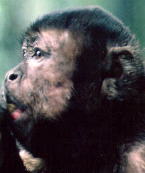Capuchins (Cebus) are called ring-tail monkeys for their habit of curling the tip of their tail. They’re very social animals and one of the most intelligent primates kept in captivity which is why they’re often used in movies. They are know to use a strong smelling substance (such as onions, orange peels or stale) to rub all over their body. Here you’ll find more information about keeping capuchins as pets.
 Brown pale-fronted capuchin (Cebus Albifrons) (c) Ivan Crab |
 White Faced Capuchin (Cebus Capucinus) (c) Philip Greenspun |
 Black-capped Capuchin (Cebus Appella) (c) Ivan Crab |
| Capuchin Care Sheets
|
Capuchin Species:
|
From Little Hands to Big Hands
February 28, 2021 12:17 am
A Very Special Re-Homing Story – by Mary Lynn Campbell

Welcome back to the Primate Care Site. We hope that you and your families have been able to remain healthy during this world pandemic. Although I have not been able to resume taking the monkeys of SunShine MonkeyShines out to local schools and birthday parties, I have been very busy networking with many of you who have needed help with your monkeys. This site has provided me with an ability to network with many monkey families all around the world. I thought it would be a wonderful time to share the story of one of these families unique experience with giving a home to two Capuchin monkeys.
Soon after writing my last post, I was contacted by someone from South America whose family in earlier years had been active in caring many of the smaller primate species. As we all know, in South America their are many different types of primates living on that continent. I hope you will enjoy hearing this story from a part of the world where New World Monkeys are actually born into wild troops.
Posted in capuchin, health, living with monkeys
Get a rehome … they said
July 14, 2017 5:41 pm

I can’t believe it but it has been over 7 years since we purchased Benji, a male cinnamon capuchin, from an animal auction. We’ve had him since he was 4 months old and while challenging at times, I truly enjoy spending time with him every single day whether it is “chase the monkey” or “cuddle time”. Just like their human counterpart, monkeys are very social animals so spending lots of time with them is crucial to keep them happy and healthy. Since humans can’t really replace the relationship they have with their own kind, we were looking for another cinnamon capuchin for quite some time because lets face it, they get bored so easily at the moments we’re not spending time with them. When trying to find a companion, the biggest chance for success is by pairing them with the same kind, same sex so we were in essence looking for another male cinnamon capuchin between the ages of 4-7. Given the fact that there aren’t that many cinnamon capuchins available in the USA, we knew we might have to be a bit flexible.
Posted in capuchin, primate story, rehome
The Story of Cooper, a Rehomed Capuchin
July 26, 2016 8:00 pm

It was the summer of 2015 and after finally being settled into our new home, it was time to apply for an USDA license so I could exhibit Benji to others and get him a buddy. Monkeys are very social animals and don’t like being by themselves. I work full-time but am lucky enough to be able to work from home. Benji has access to my home office so he can visit me any time and he often spends hours in my office but having a buddy is still a lot better than just being able to see me during the day. We spend time every day together but that isn’t until after work or during my lunch break.
Posted in capuchin, primate story, rehome
Opie’s Re-Homing Story
July 20, 2016 11:09 pm
By Mary Lynn Campbell

When I look at this photo of our “Miss Opie,” my smile (inside and out) is for her unbelievable ability to surprise us at every turn as she did with this photo. Welcome once again to our monthly post here on the Primate Care site. This is the story of a re-homed girl monkey with a boy’s name, I must add that it took several days to finally get her permission to talk about her in this post. She is definitely a girl monkey who has a mind of her own!
When I went to pick up Opie from her previous owners, she let me know instantly that she was ready to be my monkey. Her eyes were full of acceptance and awe. She had a wonderful home with her owners but after experiencing life with her they felt she needed to be with other monkeys and wanted her to have an opportunity to bond with my troop.
She is smart and beautiful but there is a list of “nutty” things about her that is a mile long! Many of the things that have made up her list have been caused by a sketchy early background that we have been trying to piece together.
Posted in capuchin, living with monkeys, monkey story
How to diaper a monkey
March 1, 2015 5:45 am

Amongst primate owners, the most commonly known method of diapering is the tail hole method but more and more primate owners are switching over to the tail wrap method. Since I’ve used both methods myself and don’t really have a particular preference, I reached out to other primate owners to find out why they prefer one method over the other. Before we go into more details, I’ve recorded a short video to demonstrate the difference between both methods. After that we’ll talk about diaper covers, different diaper brands, and what monkey parents are doing to prevent diaper rash.
Posted in baboon, bush baby, capuchin, chimpanzee, gibbon, macaque, marmoset, owl monkeys, primate care, savanna monkey, squirrel monkeys, tamarin